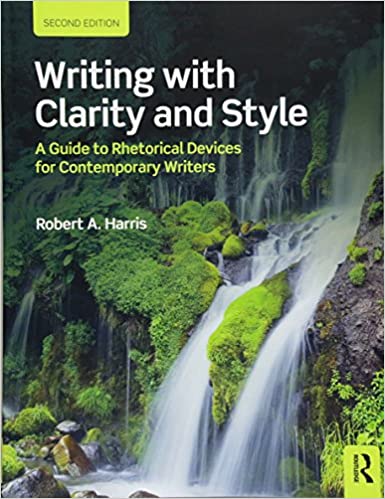Pinned 5 years 1 month ago onto Writing Guides

Writing With Clarity and Style by Robert A. Harris is the first book I have read and reviewed for my new section on writing guides that help writers to write with style. And WOW what a start!
Robert says rhetorical devices, often called figures of speech, involve the use of words in special, unusual ways: either in unusual arrangements or with special and unusual meaning. We might distinguish these as figures of structure and figures of thought.
In every case, the goal is to add clarity, interest, power and sometimes fun to the written word.
How To Write With Clarity And Style
Robert sums up his writing guide Writing With Clarity and Style this way:
- The purpose of writing is to communicate. Clear, smooth writing communicates better than muddy, awkward writing. Well-organized sentences with carefully placed emphasis make writing more easily accessible to readers. Many of the rhetorical devices in his book provides the reader with mental frameworks that ease understanding.
- Interesting writing is more likely to be read than boring writing. Every kind of writing, for every audience, can be made more interesting. Fresh expressions, visually appealing language, even an occasional dramatic effect or play on words, all of these will help maintain a reader’s interest. Thus, many of the devices in Writing With Clarity and Style can be used to stimulate curiosity and keep your reader not only focused, but eager to know what comes next. This is essential for fiction writers and novelists who want to engage the reader and give them an intimate experience with your fictional characters.
- Skilful rhetoric is a friend, not a foe, of clarity and effectiveness. The rhetorical devices in this book are presented as a set of practical tools for enhancing communication. Well-used, rhetoric will help you to become a better writer, which means a better communicator. Therefore, says Robert, this is a book for writers and novelists who wish to add power, liveliness, and attentiveness to their writing. This is a book that teaches rhetoric as the art of using language effectively.
What Is Clarity And Style?
Robert explains that many of the devices described in Writing With Clarity and Style have names that may sound odd and even downright bizarre to a modern reader, so writers should not be put off by them.
For example, do you know what the heck an Anacoluthon is?
Robert explains that 'anacoluthon' (an uh koh LOO thun) is a sentence whose two pieces do not fit together grammatically. That is, the writer begins a sentence and changes from one sentence construction to another part of the way through. When intentional, anacoluthon produces the effect of a sudden change of mind by the writer, captured on paper. The result is a sense of immediacy, that the reader is right there with the writer as the prose is being constructed.
Here's an example:
"Suddenly we heard an explosion from the direction of the hut. I turned to see the windows blowing out and the roof coming off. I began to―we were all knocked down."
So now you can see the extensive detail that Robert outlines in Writing With Clarity and Style.
Writing With Clarity And Style
Each element of writing has pronunciations, for example: Parallelism (PAR uh lel iz um). And each chapter ends with style checks, tips to define your terms, email etiquette, and 'salt and pepper' review questions and questions for thought and discussion. Ordered into chapters that reflect several elements of style such as transition, balance, clarity and emphasis, each of which have elements of writing that fit into that grouped topic.
Each chapter ends with the author using 'Salt and Pepper' to spice up the study of rhetoric by stretching the reader's thinking about how their writing can be improved, sometimes by attending to details such as punctuation, and sometimes by exploring the use of unusual techniques such as stylistic fragments. He gives exercises so writers can create their own sentences after each writing element is explained in detail with lots of examples.
The single, most important goal of writing is to be clear—without being boring. —Aristotle
Used well, all the devices featured in Writing With Clarity and Style can add richness, texture, and interest to a writer's prose that might otherwise be bald, sterile, even boring. Beautiful and thought-provoking, the writing styles in Writing With Clarity and Style are all powerful tools for effective writing.
Writing With Structure And Balance
Writing well, Robert states, involves more than merely putting one word after another. Good writing has structure and balance that make it easy to read and understand. Writing is aural (there is sound in silent reading) as well as visual. These chapters were exciting to read, showing writers that every word they type onto the pager is important for the reader to experience the journey of the book. Playing with words is vital to an engaging read.
Robert also shows writers how to add rhythm to their writing. In addition to rhythm, writing has sounds, sounds that readers hear in their minds as they read. He goes on to show various methods to bring sounds to your words.
Halfway through Writing With Clarity and Style, Robert says "I’ve stressed repeatedly how using the right rhetorical device in the right place can provide focus, emphasis, and so forth. One thing I don’t believe I’ve mentioned yet is enjoyment. Yes, why strive for cold focus, bald emphasis, and so forth when you might write in a way that your readers could actually enjoy? Readers who enjoy your writing, I am convinced, are much more likely to be persuaded by it. And they might just want to read something else you’ve written."
This is so important for fiction writers! Readers must enjoy your novel if they are going to finish it and yearn to read more of your writing. If the books are not written with style and clarity there isn't much hope of achieving this writing goal.


























